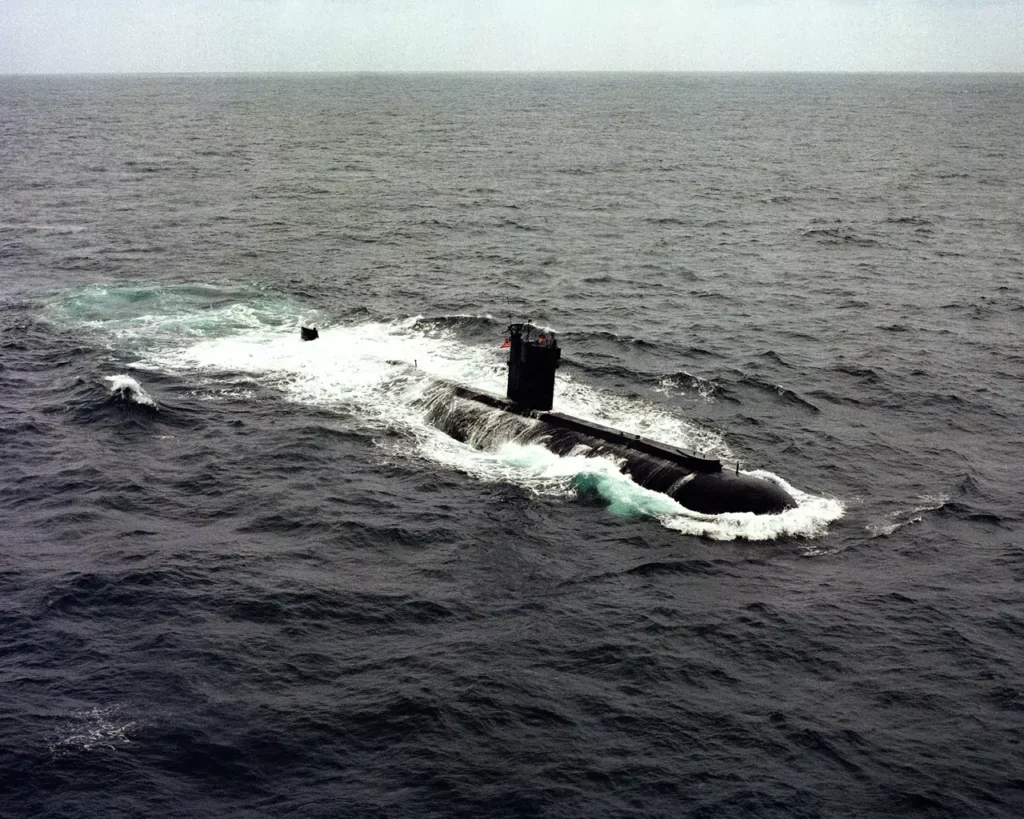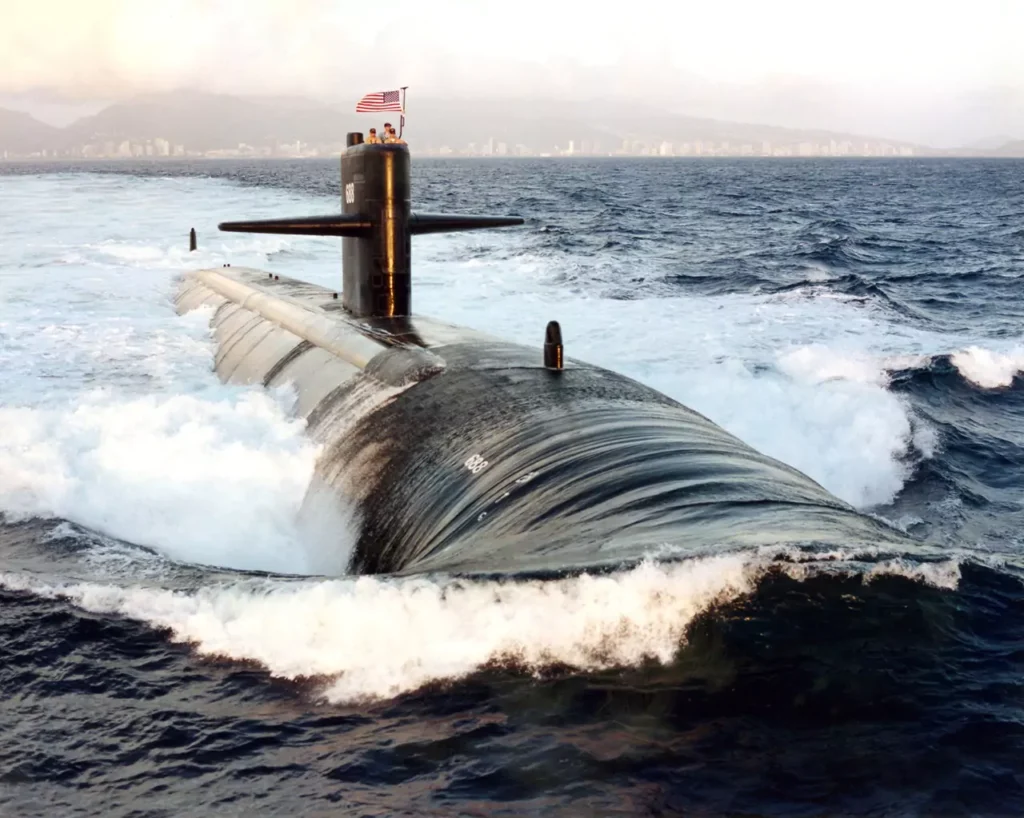Description
The AN/BQS-15 is a specialized sonar system designed for close contact and avoidance operations, particularly in challenging environments such as under-ice navigation, near icebergs, and in or near minefields. Its primary function is to detect objects in the submarine’s path and provide critical navigational data to ensure safe passage through hazardous areas.
The sonar provides a detailed display of object size and location, hull-to-surface distance (whether ice or water), polynya size and location, and keel-to-bottom depth. The system is deployed in Los Angeles-Class (SSN 688) nuclear attack submarines and Ohio-Class (SSBN-726) of nuclear ballistic submarines.
Sonar Capabilities and System Integration
The BQS-15 operates in both active and passive modes, with its main element being a cylindrical transducer housing located in the forward section of the submarine’s sail. This transducer is capable of locating and tracking targets using both high-frequency (HF) and low-frequency (LF) ranges. Although the specific frequencies remain classified, it is known that the system operates at frequencies greater than 10 kHz.
Integration of the BQS-15 with the submarine’s Central Computer Complex (CCC) is achieved through the Navigation/Interior Communications (NAV/IC) Switchboard and the Central Signal Data Converter (CSDC). The sonar system transmits range, bearing, and identifying mark signals to the CCC, which utilizes this data for precise navigation and environmental assessment.
Additionally, the system provides digital displays of keel depth, a crucial metric for under-ice navigation, conveyed through four 4-bit binary-coded decimal (BCD) digits via the CSDC interface. This interface supports both analog and digital data transmission, ensuring accurate and reliable communication between the sonar system and the submarine’s navigation systems.
Development
In the mid-1960s, Ametek-Straza, based in El Cajon, California, won a contract to develop the AN/BQS-15, an under-ice sonar system specifically designed for the new Los Angeles-class submarines (SSN-688).
However, in October 1969, the Chief of Naval Operations (CNO) directed the termination of the AN/BQS-15 program. Despite the program’s cancellation, Naval Ships Systems Command instructed Ametek-Straza to deliver two service test models (STM), designated as AN/BQS-15 (XN-1), to the Naval Undersea Research and Development Center (NURDC) in San Diego for continued development testing and evaluation.
Early Testing and Evaluation
In February 1970, the two STMs were delivered to NURDC. At the time of delivery, the models had accumulated a combined total of 1,110 hours of operation, including environmental tests performed by Hughes Aircraft Corporation. However, due to the program’s cancellation, crucial tests for explosive shock, reliability, and maintainability had not been conducted.
Testing continued at NURDC, with STM No. 2 installed at a land-based facility for detailed laboratory evaluations from March to August 1970. In August, STM No. 1 was installed in a dockside facility, where its acoustic components, such as projectors and hydrophones, were submerged to a depth of 40 feet for further testing.
At-Sea Testing on USS DOLPHIN

In January 1971, STM No. 2 was installed on the USS DOLPHIN (AGSS-555) for at-sea testing. However, significant installation problems aboard the DOLPHIN delayed the tests until April 1971. Despite these delays, the results indicated that the AN/BQS-15 system had a high probability of meeting its operational requirements when deployed on an attack submarine.
Contract Renewal
In 1972, Ametek, Inc., secured a new contract worth $3.5 million to produce additional AN/BQS-15 sonar sets, along with spare parts, data, and engineering services, for Naval Ship Systems Command. Each set cost 0.6 million dollars.
Final Configuration for SSN-688 Submarines
The final version of the AN/BQS-15 system, as configured for the SSN-688 class submarines, included several key modifications compared to the original STM installed in the USS DOLPHIN. These changes included the addition of top and bottom sounders to support under-ice navigation, a reduction in the size of the main receiving array to fit within the SSN-688, and a redesigned operator’s console to accommodate the space constraints of the SSN-688 attack center while integrating all necessary displays.
Service Approval and Deployment

By late 1975, the AN/BQS-15 system was scheduled for final service approval. The first Los Angeles-class submarine, the USS Los Angeles (SSN-688), was laid down in January 1972 and commissioned in November 1976, with the new AN/BQS-15 system onboard.
Operational Status
Operational in the following Platforms:
- Ohio-Class (SSBN-726) Nuclear Ballistic Missile Submarines
- Ohio-Class (SSGN-726) Nuclear Guided Missile Submarine
- Los Angeles-Class (SSN 688) Nuclear Attack Submarines
Contractor
- Ametek-Straza, El Cajon, California, USA
Further reading
- Ohio-Class (SSBN-726) Ballistic Missile Submarines
- Ohio-Class (SSBN-726) Submarine Technical Specification
Bibliography
- Glennon, T. D., Nye, H. E. (1983). Data Systems Technician 1 & C, Volume 2. United States: The Center.
- Atlantic Fleet Active Sonar Training: Environmental Impact Statement. (2008). United States.
- Polmar, N. (2013). The Naval Institute Guide to the Ships and Aircraft of the U.S. Fleet. United Kingdom: Naval Institute.
- Jane’s – Jane’s Underwater Warfare Systems 2000-2001 (2000). United Kingdom: Jane’s Information Group.
- Department of Defense Appropriations for Fiscal Year 1974: Hearings Before a Subcommittee of the Committee on Appropriations, United States Senate, Ninety-third Congress, First Session, on H.R. 11575, an Act Making Appropriations for the Departartment of Defense for the Fiscal Year Ending June 30, 1974, and for Other Purposes. (1973). United States: U.S. Government Printing Office.